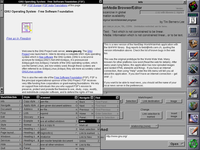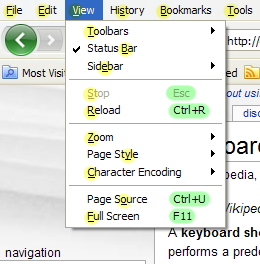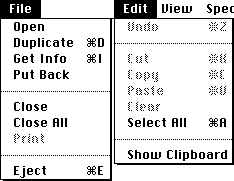Keyboard Shortcut
Contents
Description
Keyboard shortcuts are typically a means for invoking one or more commands using the keyboard that would otherwise be accessible only through a menu, a pointing device, different levels of a user interface, or via a command-line interface. Keyboard shortcuts are generally used to expedite common operations by reducing input sequences to a few keystrokes, hence the term "shortcut".[1]To differentiate from general keyboard input, most keyboard shortcuts require the user to press and hold several keys simultaneously or a sequence of keys one after the other. Other keyboard shortcuts use function keys that are dedicated for use in shortcuts and may only require a single keypress. For simultaneous keyboard shortcuts, one usually first holds down the modifier key(s), then quickly presses and releases the regular (non-modifier) key, and finally releases the modifier key(s). This distinction is important, as trying to press all the keys simultaneously will frequently either miss some of the modifier keys, or cause unwanted auto-repeat. Sequential shortcuts usually involve pressing and releasing a dedicated prefix key, such as the Esc key, followed by one or more keystrokes.
Mnemonics are distinguishable from keyboard shortcuts. One difference between them is that the keyboard shortcuts are not localized on multi-language software but the mnemonics are generally localized to reflect the symbols and letters used in the specific locale. In most GUIs, a program's keyboard shortcuts are discoverable by browsing the program's menus – the shortcut is indicated next to the menu choice. There are keyboards that have the shortcuts for a particular application already marked on them. These keyboards are often used for editing video, audio, or graphics,[2] as well as in software training courses. There are also stickers with shortcuts printed on them that can be applied to a regular keyboard. Reference cards intended to be propped up in the user's workspace also exist for many applications. In the past, when computer hardware was more standardized, it was common for computer books and magazines to print cards that were cut out, intended to be placed over the user's keyboard with the printed shortcuts noted next to the appropriate keys.
Customization
When shortcuts are referred to as key bindings it carries the connotation that the shortcuts are customizable to a user's preference and that program functions may be 'bound' to a different set of keystrokes instead of or in addition to the default.[3][4] This highlights a difference in philosophy regarding shortcuts. Some systems, typically end-user-oriented systems such as Windows, consider standardized shortcuts essential to the environment's ease of use. These systems usually limit a user's ability to change shortcuts, possibly even requiring a separate or third-party utility to perform the task. Other systems, typically Unix and related, consider shortcuts to be a user's prerogative, and that they should be changeable to suit individual preference. In most real-world environments, both philosophies co-exist; a core set of sacred shortcuts remain fixed while others, typically involving an otherwise unused modifier key or keys, are under the user's control. Hardcore gamers often customize their key bindings in order to increase performance via faster reaction times."Sacred" keybindings
The original Macintosh User Interface Guidelines defined a set of keyboard shortcuts that would remain consistent across application programs. This provides a better user experience than the situation then prevalent of applications using the same keys for different functions. This could result in user errors if one program used ⌘ Command+D to mean "Delete" while another used it to "Duplicate" an item. The standard bindings were:- Q : Quit
- ⌘ W : Close Window
- ⌘ B : Bold text
- ⌘ I : Italicize text
- ⌘ U : Underline text
- ⌘ O : Open
- ⌘ P : Print
- ⌘ A : Select All
- ⌘ S : Save
- ⌘ F : Find
- ⌘ G : Find Again (the G key is next to the F key on a QWERTY keyboard)
- ⌘ Z : Undo (resembles the action of striking out a mistake)
- ⌘ X : Cut (resembles scissors)
- ⌘ C : Copy
- ⌘ V : Paste (resembles an arrow pointing downward "into" the document, or a brush used for applying paste, as well as the proofreader's mark for "insert")
- ⌘ N : New Document
- ⌘ . (full stop): User interrupt
- ⌘ ? : Help (? signifies a question or confusion)
Problems with access keys
In summer 2002 a non-scientific study concluded that various web browsers like the IBM Home Page Reader did not make any distinction between the built in keyboard shortcuts and access keys available in websites.Notation

WorldWideWeb for NextStep with keyboard shortcuts visible at bottom left. All shortcuts require the Control key to be pressed. Additionally, the Heading commands under the Style menu and commands under the Link menu require the ⇧ Shift key to be held down.
Many shortcuts require two or more keys to be pressed together. For these, the usual notation is to list the keys names separated by plus signs or hyphens. For example: "Ctrl+C", "Ctrl-C", or "Ctrl+C". The Ctrl key is sometimes indicated by a caret character (^). Thus Ctrl-C is sometimes written as ^C. At times, usually on Unix platforms, the case of the second character is significant – if the character would normally require pressing the Shift key to type, then the Shift key is part of the shortcut e.g. '^C' vs. '^c' or '^@' vs. '^2'.
Some keyboard shortcuts require keys (or sets of keys) to be pressed individually, in sequence. Shortcuts involving the Esc key are usually this way. These shortcuts are sometimes written with the individual keys (or sets) separated by commas or semicolons. The Emacs text editor uses many such shortcuts, commonly prefixed with Ctrl+X, such as Ctrl+X S to save a file or Ctrl+X Ctrl+B to view a list of open buffers. Emacs uses the letter C to denote the Ctrl key, the letter S to denote the Shift key, and the letter M to denote the Meta key (commonly mapped to the Alt key on modern keyboards.) Thus, in Emacs parlance, the above shortcuts would be written C-x s and C-x C-b. A common backronym for Emacs is "Escape Meta Alt Ctrl Shift", poking fun at its use of many modifiers and extended shortcut sequences.
See also
- Access key
- Accelerator table
- Common User Access (CUA)
- Computer keyboard
- Human interface guidelines
- Pointing device gesture
- StickyKeys
- Table of keyboard shortcuts
Notes and references
- ^ In the English language a "shortcut" may unintentionally suggest an incomplete or sloppy way of completing something. Consequently, some computer applications designed to be controlled mainly by the keyboard, such as Emacs, use the alternative term "key binding".
- ^ Lowensohn, Josh (3 December 2009). "Hardware for Gmail: The 'Gboard' keyboard". CNET.com. Retrieved 7 January 2011.
-
^ http://www.gnu.org/software/emacs/manual/html_node/emacs/Commands.html#Commands. "Emacs does not assign meanings to keys directly. Instead, Emacs assigns meanings to named commands, and then gives keys their meanings by binding them to commands." Missing or empty
|title=(help) -
^ http://help.eclipse.org/juno/index.jsp?topic=%2Forg.eclipse.platform.doc.user%2Fconcepts%2Faccessibility%2Fkeyboardshortcuts.htm. Missing or empty
|title=(help) - ^ "OS X Human Interface Guidelines". "If your app does not perform the task associated with a recommended shortcut, think very carefully before you consider overriding it. Remember that although reassigning an unused shortcut might make sense in your app, your users are likely to know and expect the original, established meaning."
- ^ "Using Accesskeys - Is it worth it?". wats.ca. October 2006. Retrieved 7 January 2011.
External links
| Look up keyboard shortcut in Wiktionary, the free dictionary. |
This article uses material from the Wikipedia article keyboard shortcut, which is released under the Creative Commons Attribution-Share-Alike License 3.0
.
Categories
- Internet (5)
- Skype (1)
- Disability (3)
- disabled children (1)
- school (1)
- Keystrokes (6)
- Microsoft Word (3)
- bullet (1)
- bulleted list (1)
- easy (1)
- list (1)
- Windows (4)
- application control menu (1)
- maximise window (1)
- maximize window (1)
- minimise window (1)
- minimize window (1)
- restore window (1)
- Accessibility (8)
- Accessible Software (2)
- Web Accessibility (2)
- Web Stuff (2)
- Blinkz (1)
- Google Desktop (1)
- personal search engine (1)
- Computer Security (1)
- accessible (1)
- anti-virus (1)
- internet security (1)
- security (1)
- blind (1)
- Google (1)
- web search (1)
- Uncategorized (2)
- button (1)
- default button (1)
- keystroek (1)
- change font (1)
- font (1)
- keystroke (2)
- Internet Explorer (1)
- favorite (1)
- favourite (1)
- Adaware (1)
- Firewall (1)
- Lavasoft (1)
- virus guard (1)
- Zone Alarm (1)
- print screen (1)
- screen dump (1)
- Singing (16)
- laura bradshaw (6)
- London (5)
- sing for water (9)
- summer (2)
- summer singing (3)
- KRS Knee Replacement Surgery (1)
- Jaws Training (8)
- Balloon (1)
- Freedom Scientific (5)
- Gmail (1)
- Google Mail (1)
- Jaws (5)
- Jaws 9 (1)
- Jaws 9 Beta (1)
- Microsoft Office 2007 (1)
- number lock (1)
- numeral lock (1)
- numlock (1)
- Office 2007 (1)
- Outlook 2007 (1)
- tool tip (1)
- Windows Vista (2)
- Word 2007 (1)
- Testimonials (4)
- blind eye (1)
- partial vision (1)
- partially sighted (1)
- screen reader (4)
- aisquared (1)
- dolphin (2)
- magic (3)
- supernova (2)
- zoomtext (3)
- Testimonial (2)
- braille (2)
- Blog (3)
- Assistive Technology Training (3)
- availability (1)
- Cardiff (1)
- Rebecca Ballard (2)
- Wales (1)
- Magnification Training (3)
- computer training (3)
- magnification (2)
- partial sight. (2)
- visual impairment (4)
- Assistive Technology (7)
- Dolphin SuperNova (2)
- Magnification Software (3)
- Ai Squared (1)
- Fredom Scientific Magic (1)
- Jaws for Windows (4)
- Screen Readers (6)
- Training (2)
- FreedomScientific (1)
- Jaws traning (1)
- Rebecca (2)
- RSI (1)
- DVLA (1)
- tax disk (1)
- Twitter Tweats (12)
- Tweet (12)
- Event (1)
- birmingham (1)
- blazie (1)
- RNIB (1)
- sight village (1)
- version 11 (1)
- What's available (2)
- Access to Work (1)
- AtW (1)
- government (1)
- support (1)
- UK (1)
- Rebecca's availability (1)
- Rebecca's calendar (1)
- Rebecca's diary (1)
- adaptive technoogy (1)
- blindness (1)
- Braille terminal (1)
- computer user (1)
- refreshable Braille display (1)
- Speech synthesizers (1)
- Claro (1)
- HAL (1)
- NVDA (2)
- software (1)
- TextHelp (1)
- Accessible Rich Internet Applications (1)
- Michael Curran (1)
- NonVisual Desktop Acces (1)
- WAI-ARIA (1)
- iPad (3)
- 2012 (1)
- calendar (1)
- Duxbury (1)
- Windows 8 (3)
- Humanware (2)
- update (1)
- victor reader stream (2)
- victor stream (1)
- magnifier (1)
- microsoft (2)
- narrator (1)
- audible (1)
- audio books (1)
- DAISY (1)
- dyslexic. duslexia (1)
- jaws 14 (1)
- accessiblilty (1)
- Apple iPad accessibility features (1)
- ios7 accessibility (1)
- ipad accessibility (1)
- Kindle (1)
- Amazon (1)
- kindle fire accessibility (1)
- Kindle Fire HD (1)
- Kindle Fire HDX (1)
- Definitions (5)
- Toggle (1)
- ToggleKeys (1)
- keyboard (1)
- shortcut (1)
- shortcuts (1)
- Workshop (3)
- Bougabarou (1)
- Djembe (1)
- Drumming (1)
- Festive (1)
- Social Media (2)
- advertise (1)
- business (1)
- engines (1)
- leads (1)
- local (1)
- marketing (2)
- online (1)
- sales (1)
- search (1)
- small (1)
- break-even (2)
- Excel Geek (2)
- online tickets (2)
- WordPress Geek (2)
- bookings (1)
- Facebook (8)
- money (1)
- Stripe (1)
- viable (1)
- networking (1)
- choir leader (3)
- profile (1)
- follow (2)
- followers (1)
- friends (1)
- timeline (2)
- unfollow (2)
- emoticon (1)
- post (1)
- reaction (1)
- friend (1)
- news feed (1)
- newsfeed (1)
- Facebook page (2)
- choir leaders (1)
- Data Protection (1)
- GDPR (1)
- Without a Mouse (1)
- excel (1)
- PowerPoint (1)
- protected view (1)
- Word (1)
- windows 10 (1)
- startup (1)
- attachment (1)
- sing for water london (1)



0 comments
Leave a comment
Please log in or register to post a comment